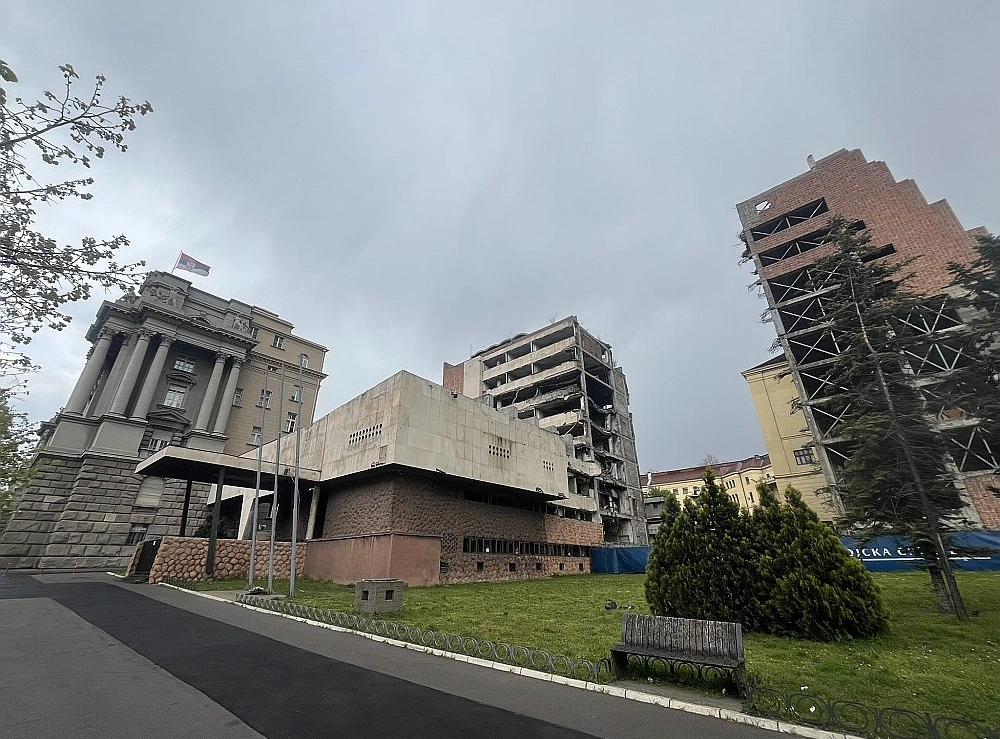Cultural Heritage or Political Deal? Serbia Revokes Landmark’s Protected Status

Katarina Baletic ,”Balkan Insight” / Latvijas Avīze
Serbia has been shaken by student-led protests that erupted after the collapse of the railway canopy in Novi Sad, a disaster that left 16 people dead. Just 13 days after the tragedy, the Serbian government decided to revoke the status of cultural heritage from the Yugoslav Army Headquarters building (Generalštab)
Modernist architectural monument
According to a student from the Faculty of Applied Arts in Belgrade, the authorities in Serbia hoped this news would go unnoticed. However, the public has since protested the decision. Several initiatives have been submitted to assess the constitutionality of the government’s move. At the end of March, students organized a protest and are now gathering signatures to propose a citizens’ initiative to the National Parliament.
“It didn’t go unnoticed, and we won’t let their arrogant and shameless plan pass, because this is the last line of defense for us as a people. When you destroy a nation’s history, you destroy the nation itself,” said the student, who asked to remain anonymous.
Europa Nostra, the largest and most representative heritage network in Europe, described the Generalstab as “a masterpiece of Serbian, Yugoslav, and European modernist architecture.”
The building was severely damaged during the NATO bombing in 1999 and has been waiting for more than 25 years for a proper preservation and rehabilitation plan.
Jared Kushner’s and Vučić’s plans
The decision to revoke its cultural heritage status aligned with earlier plans by the leadership of the ruling Serbian Progressive Party to hand over the land where the building is located to Jared Kushner, son-in-law of former US President Donald Trump, for his new development project.
The Yugoslav Army HQ is located on Nemanjina Street—one of Belgrade’s main roads—where the government building, the National Bank, and several ministries are also situated.
In May 2024, then-Minister of Construction, Transport and Infrastructure Goran Vesić signed a contract with Asher Abehsera, director of Affinity Global Development, for the revitalization of the former Army General Headquarters, which was demolished during the NATO bombing in 1999.
Affinity Partners is Kushner’s investment firm. According to media reports, it is backed by $2 billion from Saudi Arabia’s Public Investment Fund, among other foreign investors.
A month later, in June 2024, Jared Kushner met with Serbian President Aleksandar Vučić to present his hotel project for the site.
“Jared Kushner presented to me a project for a magnificent hotel in Belgrade that will help our capital become the center of this part of the world, positioning it on the global map as an unmissable destination and
a desirable seat for major corporations, universities, and international institutions, as well as an inspiration for artists, scientists, and above all, young people from all over the world,” Vučić wrote on his Instagram profile.
“It is inappropriate for a hotel to stand in the administrative center of a country’s capital, right across from the government building,” the student said.
“They illegally gave him [Kushner] the land. That land belongs to all citizens of Serbia,” she added.
In addition to the Generalštab, visual renderings of Kushner’s future project show that it also includes the area of the 7th Regiment Barracks—one of the first modern military facilities in Belgrade—which is also a protected cultural monument.

Screenshot from X (MS Kushner X)
Wants to take away the status of a cultural monument
The Renewables and Environmental Regulatory Institute (RERI), a regional think tank focused on environmental protection, energy, and urban development, is one of the organizations that submitted an initiative to the Constitutional Court to review whether the decision to remove the building’s protected status complies with the Serbian Constitution.
As RERI architect and urban planner Dragomir Ristanović explains, the Constitutional Court has no deadline to respond to such initiatives, nor is it obligated to make a ruling—only to “review” the matter.
“We cannot prejudge what the Constitutional Court will decide, but personally I don’t see how it could go any other way if they take up the case.
These decisions are so unlawful and unconstitutional that there’s no room for subjective interpretation or an alternative conclusion other than that they must be annulled,”
Ristanović said.
He explains that the government violated the law by bypassing proper procedure for lifting protection from a cultural monument. According to him, the government is not authorized to decide whether a cultural asset should lose that status—the only competent body is the Republic Institute for the Protection of Cultural Monuments.
The Institute has refused to remove the Generalstab from its registry of cultural monuments. According to the student, this institution has stood with the students from the start.
“The Institute is with us, they refused to delete the Generalstab from the registry, they’ve gone on strike and are supporting the students,” she said.
Many theaters, cultural institutions, faculties, and schools have also shown support by halting their work and entering a form of strike.
Ristanović called the Institute’s action “a heroic act,” noting that it refused to delete the building from the registry “despite pressure and in defiance of actions that contradict all professional and moral principles.”
He explains that the situation is now legally complex. The government’s decision means the building is no longer technically protected, but it still retains cultural monument status as long as it remains in the Institute’s registry.
Not only did the government fail to consult the competent institution, but it also violated legal standards. To revoke protected status, a building must first lose the characteristics for which it was declared a monument in the first place.
This requires a formal study explaining in detail why it is believed the monument no longer holds its foundational values, which could then justify the lifting of its protection.
“A cultural monument can only be deleted from the register—and thus lose protection—if it has lost the values it was recognized for,” Ristanović emphasized. “But nothing fundamental has changed in the overall condition of the building,” he added, reminding that the structure was placed under protection in 2005—after it had already been bombed and damaged.
He added that cultural protection implies “active preservation,” meaning a form of restoration was always foreseen but never implemented.
However, based on visual renderings of Kushner’s project, Ristanović says the buildings are unlikely to be preserved or restored, but rather demolished to make room for skyscrapers.
The Generalštab was designed by renowned architect Nikola Dobrović and completed in the 1960s. In September last year, Europa Nostra called for its protection, stating that Serbia is violating “its obligations under international and European conventions that it has ratified.”
Serbian experts, gathered at the Faculty of Architecture in Belgrade, also called in May 2024 for the annulment of all contracts, decisions, and plans that violate the Constitution and Serbian law.

Screenshot from X (MS Belgrade Guest)
REFERENCE
Belgrade bombing
The NATO air bombing was carried out during the Kosovo War between 24 March 1999 and 10 June 1999 until an agreement was reached on the withdrawal of the Yugoslav Army from Kosovo and the UN peacekeeping mission.
NATO’s intervention was triggered by the bloodshed by Yugoslavia and ethnic cleansing of Kosovo’s Albanians. Yugoslavia had killed around 2,000 Kosovo fighters, 10,317 civilians were killed or missing, 85 percent of them Kosovan Albanians, while about 848,000 were expelled from Kosovo.
On April 30, 1999, NATO bombed a Yugoslav Defence Ministry building in downtown Belgrade with two missiles 15 minutes apart. Another missile hit it at midnight on May 7.
At the time of the attack, the building was empty and its bombing was considered a symbolic NATO stock.
NATO bombing in 1999 killed a total of about 1,000 members of Yugoslavia’s security forces, killing around 500 civilians.
Currently, in the undamaged part of the building of the former Yugoslav Army Headquarters Tower B is the Serbian Ministry of Defence.
Source: news agencies
